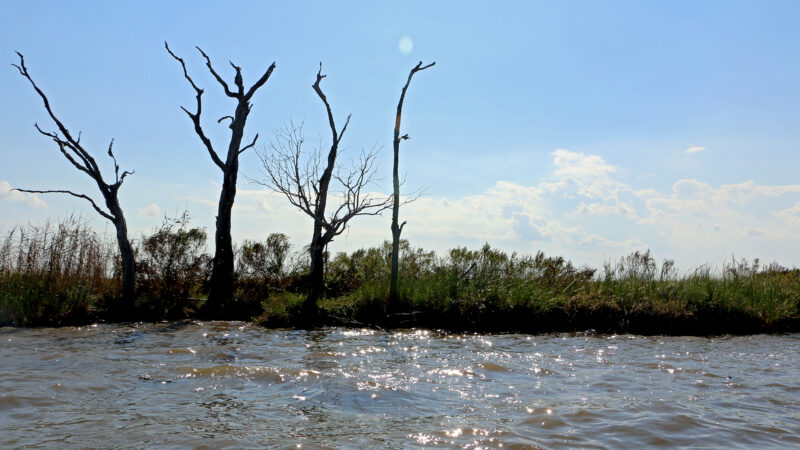In coastal Louisiana, a sacred mound is returned to the Native American tribe who built it
Dead lemon trees stick out of the ground of a sacred mound in Adams Bay in Louisiana on Sept. 20th, 2024. The mound is slowly disappearing because of coastal land loss.
By Drew Hawkins & Danny McArthur/Gulf States Newsroom
Billowy, Gulf clouds fill the afternoon sky as a table is set up in the center of Grand Bayou Indian Village. While technically in Port Sulphur, Louisiana, the village is home to the Atakapa-Ishak/Chawasha tribe, one of the small Native American communities still living in the marshes and bayous of Southeast Louisiana.
A sunflower-printed tablecloth is spread over the surface. Nearby, a crowd of volunteers with the Coalition to Restore Coastal Louisiana (CRCL) — a state agency that partners with the tribe to help build artificial reefs with bags of recycled oyster shells — catch up, finish their lunch and hydrate after a long morning of work out on the water.
“If everybody could just please keep it quiet for a few minutes, thank you,” one of the CRCL coordinators shouts.
The crowd goes silent as two people approach the table: Interim Rector Marian D. Fortner from St. Paul’s Episcopal Church in New Orleans, dressed in the black vestments of the clergy, and Rosina Philippe, an elder of the Atakapa-Ishak/Chawasha tribe, in white rubber boots with her dark hair in a braid beneath her sunhat.
Fortner introduces herself to Philippe. The two women shake hands, smile and take a seat at the table. Flanking them are two lawyers, who place a few documents on the sunflower tablecloth for the two leaders to sign. The church is about to return a 600-acre swath of land — which includes a sacred mound — to the tribe that was taken from them hundreds of years ago.
Philippe never thought she’d see this day in her lifetime.
“It’s unprecedented that we see someone willingly giving land back,” she says.
The land that’s being returned is sacred to the tribe. But it’s also disappearing — along with much of Louisiana’s coast — because of rising sea levels, sinking marshlands and man-made manipulation of the Mississippi River.
Still, tribal connections can’t be so easily severed. For the Atakapa-Ishak/Chawasha tribe returning the land to its original inhabitants and caretakers is a step toward climate justice, recognizing the deep-rooted ties Indigenous communities have to these threatened environments and their role in leading sustainable stewardship of lands they have long called home.
‘A gift from the creator’
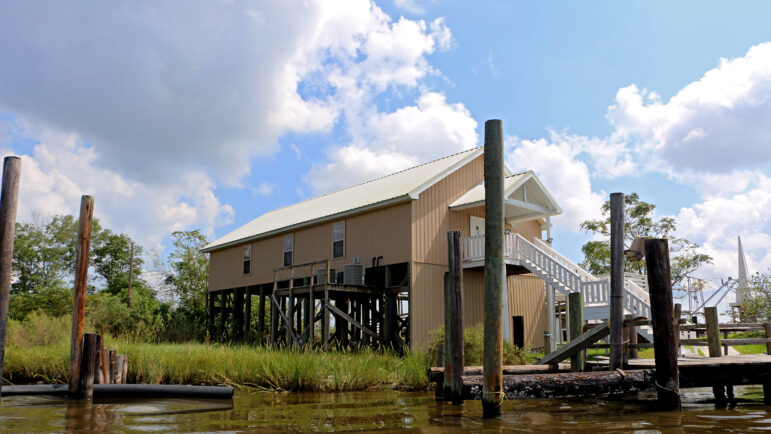
Philippe has lived in Grand Bayou Indian Village her entire life. She says her people are water people — you have to take a boat to get to anywhere in the village, including her house.
Water is everything to the Atakapa-Ishak/Chawasha.
“It’s part of life. It’s life-giving. And if you don’t respect it, and if you don’t pay attention to it, it can also take your life,” she said.
Her people survived on the water by building mounds like the one being returned to them. They built these ancient earthworks from shells and shards of pottery, piled up into large hills. Philippe said when the river would flood, they’d seek refuge on the mounds and wait for the water to recede. It was all part of the natural ebb and flow of the river — before structures like levees were built to control the flow of water.
The mound being returned to the tribe is known as the “Lemon Tree” mound. Philippe said her tribe would bring offerings to their ancestors there. At some point — maybe from an offering, but no one knows exactly how or when — lemon trees sprouted there.
“To the people, that’s a gift from the creator,” she said.
Today, the mound is just a tuft of grass in the water. A “remnant mound,” as Philippe puts it. But the memory is still strong for her.
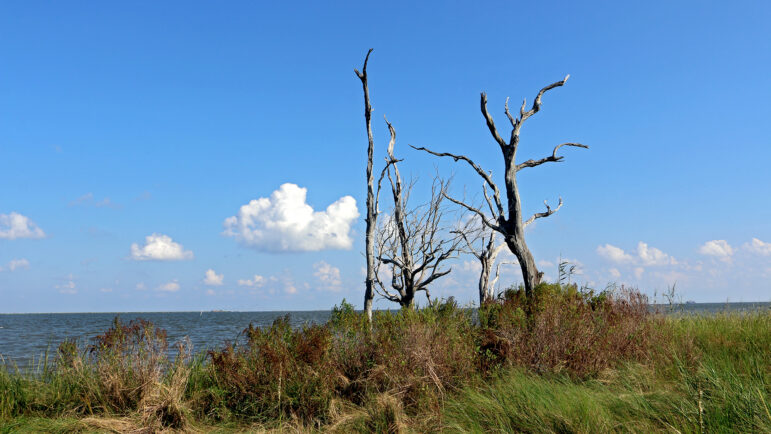
She laughs and tells stories her father told her when she was a little girl.
“He would always tell us that the lemons were this big,” she says, holding out her hands to form a circle about the size of a grapefruit. “And they were so sour, one lemon could make a whole pitcher of lemonade.”
But even though her people built the Lemon Tree mound, the land was taken from them — something that’s been happening to many other tribes in the U.S. since the country’s founding.
Over hundreds of years, the land has changed hands numerous times. But in the 1990s, the last owner died and bequeathed the land to St. Paul’s Episcopal Church.
Fortner said the title was put away in storage in New Orleans because previous clergy were unsure of exactly what to do with it. Then it was moved around after storms like Hurricanes Katrina and Ida.
But earlier this year, the church found the document. Fortner said the decision to give the land back to the tribe was an easy one.
“I think giving back a piece of their heritage, their land for their tradition, their sacred space would be equivalent to someone returning our church to us,” she said.
‘Returning to the original matriarchs’
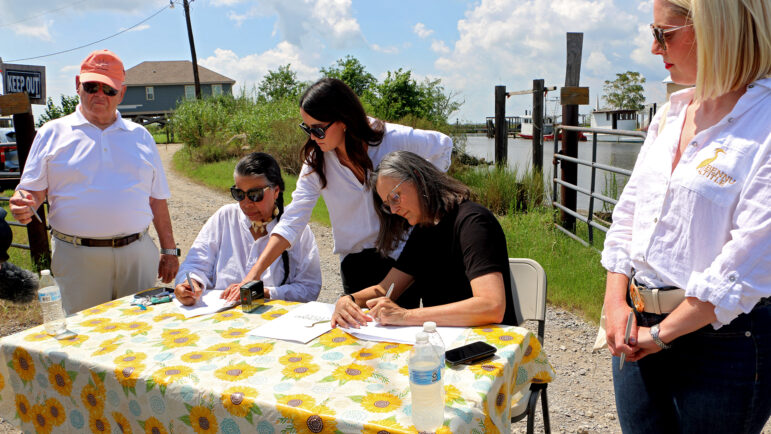
Back at the ceremony, the paperwork to transfer ownership of the Lemon Tree mound back to the tribe is placed on the table in front of Philippe and Fortner.
Lawyers begin to explain it to them before they sign it, but to Philippe and her tribe, this is much more than a simple legal procedure, like a car title or a deed transfer. This is a “rematriation” ceremony. For many Indigenous people across the country, that term is really important.
Kyle Hill, a member of the Turtle Mountain Band of Ojibwe tribe and professor at the University of Minnesota who studies rematriation and climate justice efforts in the U.S., said repatriation recognizes the patriarchal quality of ownership and possession. Rematriation, on the other hand, recognizes the leadership “of the matriarchs in our communities — the mothers, the grandmothers, the daughters.”
Hill said ceremonies like these are the first step toward healing the land. Rematriation gives the tribe and elders like Philippe a chance to care for their land again.
“It’s returning to the original stewards, the original matriarchs, the original beings of this land,” he said.
Philippe signs the documents in less than five minutes — just a few strokes of the pen — and the ceremony is done.
The sacred mound officially returns to the Atakapa-Ishak/Chawasha tribe. Philippe is emotional as she talks about what this means for her people.
“I think the ancestors are dancing,” she says. “I know that I’m dancing in my heart. And I can’t wait to move forward from this point… receiving that gift.”
‘The apocalypse has happened here’
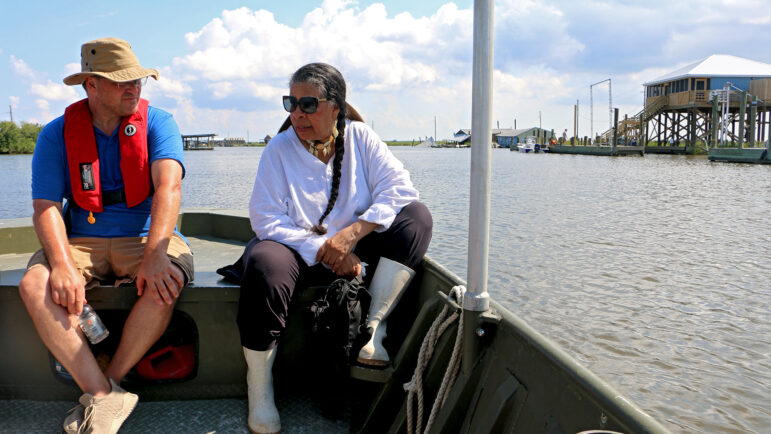
With the ceremony finished, Philippe steps into a flat-bottomed metal boat to head out to the Lemon Tree mound — this time, not as a visitor, but as one of its rightful owners.
Traveling through the marsh, she points out water where land used to be.
“No more trees,” she says. “Majority of them are gone.”
Boat captain Richie Blink, with Delta Discovery Tours, is leading the trip to the Lemon Tree mound. He puts it another way.
“The apocalypse has happened here,” he says.
Blink asks if everyone is ready to go a little faster. In the distance are petrochemical plants. A sign sticking out of the water warns about gas pipelines beneath the surface.
After about an hour, the boat pulls up to the mound’s shore. It barely peeks out above the water. The lemon trees are dead — nothing more than dry husks sticking out of the mud.
Still, coming to the mound after the rematriation ceremony feels different for Philippe.
“It feels different in my spirit,” she says.
Tribes like the Atakapa-Ishak/Chawasha often bear the brunt of climate change because their traditions and livelihoods are dependent on their relationship to their traditional territories and homelands. In his work, Hill said this connection to disappearing land can also lead to Indigenous traditions, cultures and beliefs eroding.
“They’re just too interdependent,” Hill said.
This interdependence impacts Indigenous people deeply when it comes to maintaining their livelihood, their culture and their ceremonial practices, according to “Rematriation and climate justice: Intersections of Indigenous health and place,” a paper Hill co-wrote.
“When we couple that with the devastation of settler colonialism — this era of assimilation, forced acculturation — you see that… we’re really trying to reclaim our traditions, our spiritualities and our cultures that are all land-based,” Hill said.
This is why even though the Lemon Tree mound will soon be completely submerged beneath the water, it’s still sacred, Hill said, and why the tribe would want to take it back.
“We have the tools to be able to breathe life back into our lands,” he said.
‘The damage that’s been caused’
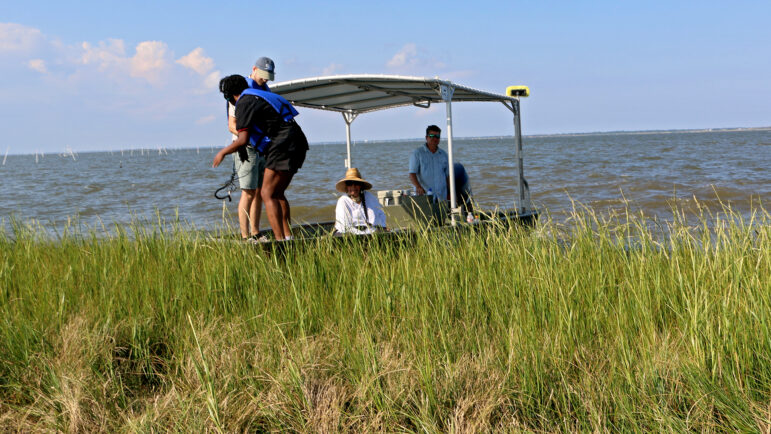
Hill’s sentiment is one the Atapaka-Ishak/Chawasha tribe echoes in their work to protect the Lemon Tree mound.
Ringing the mound are cement-gray oyster shells, flecked with blue — put there by the CRCL. On the oyster reef, you can already see signs of life. A stone crab here, small schools of fish there.
The reef was built to protect the mound against erosion, storm surges and the other dangers that come with being surrounded by water where the Mississippi and Gulf meet. The goal is to slow the rate of land loss.
This effort, however, is fighting an uphill battle.
Misty Blue, another co-writer on Hill’s rematriation paper, said the hard truth about the land being returned to Indigenous stewardship is it will never be the same as before colonization.
“These places will never look the same,” Blue said. “But we can do what we can. All humans need to be doing this — trying to make up for the damage that’s been caused.”
Blue’s seen some positive examples of Indigenous groups reclaiming land and learning to work with nature, such as the Ekvn-Yefolecv Maskoke eco-village located in the traditional Maskoke homelands in Alabama. There, residents are trying to come up with ways of living off-grid by using renewable energy and practicing minimalism to use fewer resources.
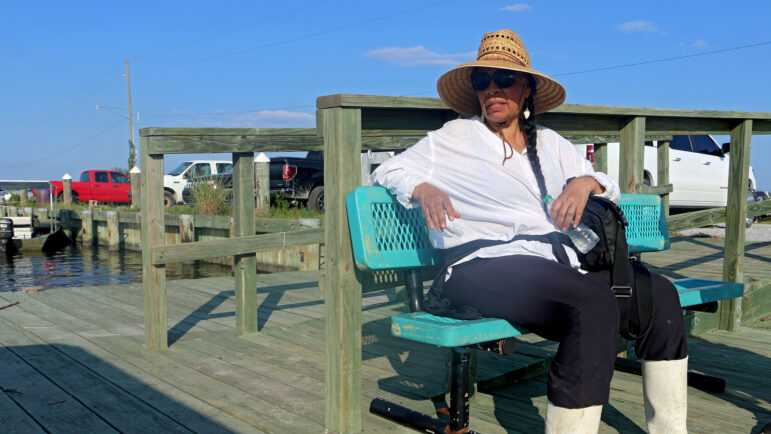
After gazing over the mound, Philippe returns to the village and sits on a bench on the dock, continuing to contemplate what the land transfer will mean — not only for their current tribe, but for their future people as well.
She says this is the first time stolen land has been returned to Indigenous people in Louisiana, but she hopes it can lead to a “domino effect” and lead to more land rematriation in the Gulf South and across the country.
“There are so many tribes up along the coast that would love to lay claim to some of their sacred places,” she says.
For now, her tribe’s work will be focused on more projects to help slow the erosion of the Lemon Tree mound — To help the earth heal its wounds as best they can, and keep the memory alive.
This story was produced by the Gulf States Newsroom, a collaboration between Mississippi Public Broadcasting, WBHM in Alabama, WWNO and WRKF in Louisiana and NPR.
Top Instagram reels from Goats and Soda in 2025: Plumpy’Nut, aid cuts, soccer grannies
Our most-viewed Instagram videos include reports from a Rhode Island factory that makes special food for malnourished children and from a tournament for soccer-playing "grannies."
‘The Rest of Our Lives’ takes readers on a midlife crisis road trip
America's literary highways may be plenty crowded with middle-aged runaways fleeing lives that increasingly feel like a bad fit. But Ben Markovits adds a moving tale to the collection.
Hunker down with these 13 mysteries and thrillers from 2025
Mysteries and thrillers are enjoyable no matter the season, but there's something extra satisfying about curling up in the winter with a warm drink and an all-engrossing read. Here's what we suggest.
Should the U.S. model its vaccine policy on Denmark’s? Experts say we’re nothing alike
The Trump administration wants to revamp U.S. childhood vaccination recommendations to align with some other peer nations, including one tiny country in northern Europe.
Marijuana rescheduling would bring some immediate changes, but others will take time
President Trump set the process in motion to ease federal restrictions on marijuana. But his order doesn't automatically revoke laws targeting marijuana, which remains illegal to transport over state lines.
The cultural works becoming public domain in 2026, from Betty Boop to Nancy Drew
The original Betty Boop, the first four Nancy Drew books and Greta Garbo's first talkie are among the many works from 1930 that will be free to use, share and remake starting on Jan. 1.

